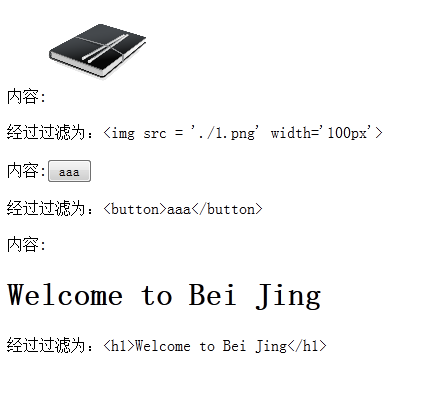本文實例講述了Zend Framework過濾器Zend_Filter用法。分享給大家供大家參考,具體如下:
引言:過濾器是對輸入內容進行過濾,清除其中不符合過濾規則的內容,並將其余內容返回的過程。
Zend中有個Zend_Filter組件用來實現過濾的功能。其中有個Zend_Filter_Interface子類,該子類為實現一般過濾器提供了接口。
要實現過濾器類,需要實現該接口中一個名為filter()的方法。
下面通過實例來演示如何使用Zend_Filter中定義的過濾器,該例演示如何實現字母轉小寫的功能。
代碼:
<?php require_once 'Zend/Filter/StringToLower.php'; //加載子類 $filter = new Zend_Filter_StringToLower; //實例化對象 $temp1 = "ABCDefGH"; //定義待過濾內容 $temp2 = "我愛Nan Jing"; echo "內容:".$temp1."<p>經過濾後為:"; echo $filter->filter($temp1); echo "<p>"; echo "內容:".$temp2."<p>經過濾後為:"; echo $filter->filter($temp2);
結果:
內容:ABCDefGH
經過濾後為:abcdefgh
內容:我愛Nan Jing
經過濾後為:我愛nan jing
為什麼如此神奇呢?不禁讓我想探索一下其內部的構造!下面來研讀一下其內部的工作原理。
class Zend_Filter_StringToLower implements Zend_Filter_Interface
{
/**
* Encoding for the input string
*
* @var string
*/
protected $_encoding = null;
/**
* Constructor
*
* @param string|array|Zend_Config $options OPTIONAL
*/
public function __construct($options = null)
{
if ($options instanceof Zend_Config) {
$options = $options->toArray();
} else if (!is_array($options)) {
$options = func_get_args();
$temp = array();
if (!empty($options)) {
$temp['encoding'] = array_shift($options);
}
$options = $temp;
}
if (!array_key_exists('encoding', $options) && function_exists('mb_internal_encoding')) {
$options['encoding'] = mb_internal_encoding();
}
if (array_key_exists('encoding', $options)) {
$this->setEncoding($options['encoding']);
}
}
/**
* Returns the set encoding
*
* @return string
*/
public function getEncoding()
{
return $this->_encoding;
}
/**
* Set the input encoding for the given string
*
* @param string $encoding
* @return Zend_Filter_StringToLower Provides a fluent interface
* @throws Zend_Filter_Exception
*/
public function setEncoding($encoding = null)
{
if ($encoding !== null) {
if (!function_exists('mb_strtolower')) {
require_once 'Zend/Filter/Exception.php';
throw new Zend_Filter_Exception('mbstring is required for this feature');
}
$encoding = (string) $encoding;
if (!in_array(strtolower($encoding), array_map('strtolower', mb_list_encodings()))) {
require_once 'Zend/Filter/Exception.php';
throw new Zend_Filter_Exception("The given encoding '$encoding' is not supported by mbstring");
}
}
$this->_encoding = $encoding;
return $this;
}
/**
* Defined by Zend_Filter_Interface
*
* Returns the string $value, converting characters to lowercase as necessary
*
* @param string $value
* @return string
*/
public function filter($value)
{
if ($this->_encoding !== null) {
return mb_strtolower((string) $value, $this->_encoding);
}
return strtolower((string) $value);
}
}
研讀:
源代碼意思大概是先實現Zend_Filter_Interface接口。
定義一個私有變量$_encoding,初始值為null,一般私有變量都是以_下劃線開頭。
然後通過構造函數進行初始化工作,設置encoding。
至於這個encoing屬性是作何用的,我就不大清楚了,反正為了它,源碼寫了不少代碼。
類中有三個方法,一個是setEncoding,一個是getEncoding,一個主要功能的filter。有兩個方法都是為了encoding來寫的。
在構造函數中使用setEncoding方法直接用$this->setEncoding()就可。就可以把私有屬性設置好值了。
然後根據私有屬性的內容來選擇使用什麼方法來使得字母變小寫。
我去,這個類考慮的東西還真夠多的。其實核心代碼就那兩句,strtolower((string) $value)。
這個類很酷,我從來沒用過私有屬性。考慮問題也沒有作者那麼全面,各種驗證,各種情況考慮。比如,
從構造函數中就可以看出他考慮問題的全面性。
if ($options instanceof Zend_Config) {
$options = $options->toArray();
} else if (!is_array($options)) {
$options = func_get_args();
$temp = array();
if (!empty($options)) {
$temp['encoding'] = array_shift($options);
}
$options = $temp;
}
if (!array_key_exists('encoding', $options) && function_exists('mb_internal_encoding')) {
$options['encoding'] = mb_internal_encoding();
}
if (array_key_exists('encoding', $options)) {
$this->setEncoding($options['encoding']);
}
總的來說還是值得佩服的。
下面談談過濾器鏈,它的作用是將多個過濾器串聯起來配合使用。過濾器鏈就是多個過濾器的一個連接。在對指定的內容進行過濾時,
每個過濾器將按照其順序分別進行過濾或者轉化操作。當所有的過濾操作都執行完畢時,過濾器鏈返回最終的過濾結果。
聽起來蠻有趣的啊!
具體實現步驟是什麼呢?
首先要為類Zend_Filter實例化一個對象,然後通過該實例的addFilter()方法向過濾器鏈中添加過濾器。
下面通過示例演示如何使用過濾器鏈對數據進行多重過濾及轉化。
代碼:
<?php
require_once 'Zend/Filter.php'; //加載Zend_Filter類
require_once 'Zend/Filter/Alpha.php'; //加載Zend_Filter_Alpha子類
require_once 'Zend/Filter/StringToUpper.php'; //加載Zend_Filter_StringToUpper子類
$filterChain = new Zend_Filter(); //創建過濾器鏈
$filterChain ->addFilter(new Zend_Filter_Alpha(" "))
->addFilter(new Zend_Filter_StringToUpper());//向過濾器鏈中添加過濾器
$temp1 = "12345asdf67asdfasdf";
$temp2 = "#$%^!@fffff";
$temp3 = "Welcome to Bei Jing";
echo "內容:".$temp1."<p>經過過濾後為:";
echo $filterChain->filter($temp1);
echo "<p>";
echo "內容:".$temp2."<p>經過過濾後為:";
echo $filterChain->filter($temp2);
echo "<p>";
echo "內容:".$temp3."<p>經過過濾後為:";
echo $filterChain->filter($temp3);
echo "<p>";
結果:
內容:12345asdf67asdfasdf
經過過濾後為:ASDFASDFASDF
內容:#$%^!@fffff
經過過濾後為:FFFFF
內容:Welcome to Bei Jing
經過過濾後為:WELCOME TO BEI JING
分析:
這裡的Alpha很強大啊,過濾數字和特殊字符,連空格都能過濾。還好我初始化的時候加了個參數" ",才使得空格保留了下來。
為何如此神奇呢?
核心代碼就這一塊
public function filter($value)
{
$whiteSpace = $this->allowWhiteSpace ? '\s' : '';
if (!self::$_unicodeEnabled) {
// POSIX named classes are not supported, use alternative a-zA-Z match
$pattern = '/[^a-zA-Z' . $whiteSpace . ']/';
} else if (self::$_meansEnglishAlphabet) {
//The Alphabet means english alphabet.
$pattern = '/[^a-zA-Z' . $whiteSpace . ']/u';
} else {
//The Alphabet means each language's alphabet.
$pattern = '/[^\p{L}' . $whiteSpace . ']/u';
}
return preg_replace($pattern, '', (string) $value);
}
分析:這裡對內容進行過濾,如果不是字母或者空格,就統統去掉。用到的php方法是preg_replace。此外,還用到了正則表達式。[^a-zA-Z]表示除此之外的其他字符。
這裡的$whiteSpace成員屬性,是初始化的時候設置的,具體代碼如下:
public function __construct($allowWhiteSpace = false)
{
if ($allowWhiteSpace instanceof Zend_Config) {
$allowWhiteSpace = $allowWhiteSpace->toArray();
} else if (is_array($allowWhiteSpace)) {
if (array_key_exists('allowwhitespace', $allowWhiteSpace)) {
$allowWhiteSpace = $allowWhiteSpace['allowwhitespace'];
} else {
$allowWhiteSpace = false;
}
}
$this->allowWhiteSpace = (boolean) $allowWhiteSpace;
if (null === self::$_unicodeEnabled) {
self::$_unicodeEnabled = (@preg_match('/\pL/u', 'a')) ? true : false;
}
if (null === self::$_meansEnglishAlphabet) {
$this->_locale = new Zend_Locale('auto');
self::$_meansEnglishAlphabet = in_array($this->_locale->getLanguage(),
array('ja', 'ko', 'zh')
);
}
}
此外,還有兩個方法來設置是否允許有空格和獲取是否設置了允許空格。
/**
* Returns the allowWhiteSpace option
*
* @return boolean
*/
public function getAllowWhiteSpace()
{
return $this->allowWhiteSpace;
}
/**
* Sets the allowWhiteSpace option
*
* @param boolean $allowWhiteSpace
* @return Zend_Filter_Alpha Provides a fluent interface
*/
public function setAllowWhiteSpace($allowWhiteSpace)
{
$this->allowWhiteSpace = (boolean) $allowWhiteSpace;
return $this;
}
剖析完之後,我們似乎就更了解它的構造了,就是使用正則過濾而已。同時通過屬性allowWhiteSpace來控制是否過濾空格。
剛才介紹了兩種過濾器,一個是StringToUpper,一個是Alpha,下面再介紹其它的一些過濾器。
首先是Alnum,過濾非數字和非字母的內容,執行filter()方法,將返回純數字與字母的內容,它是Zend_Filter_Alpha(過濾非字母)與Zend_Filter_Digits(過濾非數值)的並集。
具體的例子就不舉了,都差不多。
我們來看看它內部的構造,
public function filter($value)
{
$whiteSpace = $this->allowWhiteSpace ? '\s' : '';
if (!self::$_unicodeEnabled) {
// POSIX named classes are not supported, use alternative a-zA-Z0-9 match
$pattern = '/[^a-zA-Z0-9' . $whiteSpace . ']/';
} else if (self::$_meansEnglishAlphabet) {
//The Alphabet means english alphabet.
$pattern = '/[^a-zA-Z0-9' . $whiteSpace . ']/u';
} else {
//The Alphabet means each language's alphabet.
$pattern = '/[^\p{L}\p{N}' . $whiteSpace . ']/u';
}
return preg_replace($pattern, '', (string) $value);
}
通過正則過濾除字母和數字之外的內容。
下面出場的是HtmlEntities HTML過濾器。
代碼:
<?php require_once 'Zend/Filter/Htmlentities.php'; $filter = new Zend_Filter_HtmlEntities(); $temp1 = "<img src = './1.png' width='100px'>"; $temp2 = "<button>aaa</button>"; $temp3 = "<h1>Welcome to Bei Jing</h1>"; echo "內容:".$temp1."<p>經過過濾為:"; echo $filter->filter($temp1); echo "<p>"; echo "內容:".$temp2."<p>經過過濾為:"; echo $filter->filter($temp2); echo "<p>"; echo "內容:".$temp3."<p>經過過濾為:"; echo $filter->filter($temp3); echo "<p>";
結果:

通過結果,我們看出它將html內容還原成原始代碼了。由於該過濾器是對函數htmlentities進行的封裝,所以遵循該函數的規則。即將“<”與“>”分別轉換為“<”與“>”,經過這樣的轉換,
相應的HTML內容就變成了以其原始格式顯示的字符串。
更多關於zend相關內容感興趣的讀者可查看本站專題:《Zend FrameWork框架入門教程》、《php優秀開發框架總結》、《Yii框架入門及常用技巧總結》、《ThinkPHP入門教程》、《php面向對象程序設計入門教程》、《php+mysql數據庫操作入門教程》及《php常見數據庫操作技巧匯總》
希望本文所述對大家基於Zend Framework框架的PHP程序設計有所幫助。